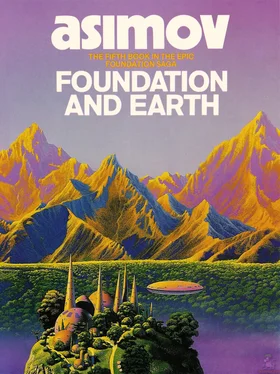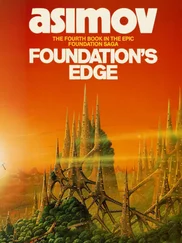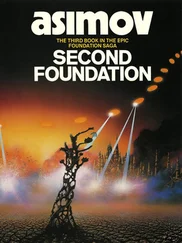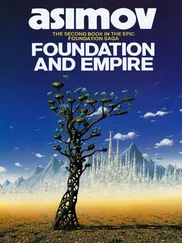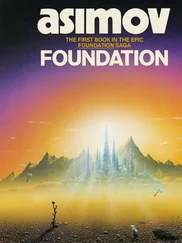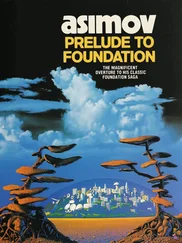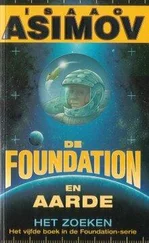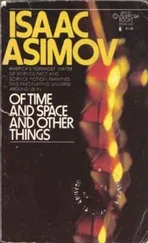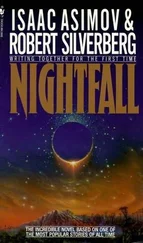The ship now moved out of the daylit hemisphere into the night. The effect was that of a rapidly deepening twilight, and then utter darkness outside, except for starlight where the sky was clear.
The ship maintained its height by accurately monitoring the atmospheric pressure and gravitational intensity. They were at a height too great to encounter any upthrusting mountainous massif, for the planet was at a stage when mountain-building had not recently taken place. Still, the computer felt its way forward with its microwave finger-tips, just in case.
Trevize regarded the velvety darkness and said, thoughtfully, “Somehow what I find most convincing as the sign of a deserted planet is the absence of visible light on the dark side. No technological society could possibly endure darkness. —As soon as we get into the dayside, we’ll go lower.”
“What would be the use of that?” said Pelorat. “There’s nothing there.”
“Who said there’s nothing there?”
“Bliss did. And you did.”
“No, Janov. I said there’s no radiation of technological origin and Bliss said there’s no sign of human mental activity, but that doesn’t mean there’s nothing there. Even if there are no human beings on the planet, there would surely be relics of some sort. I’m after information, Janov, and the remainders of a technology may have its uses in that direction.”
“After twenty thousand years?” Pelorat’s voice climbed in pitch. “What do you think can survive twenty thousand years? There will be no films, no paper, no print; metal will have rusted, wood will have decayed, plastic will be in shattered grains. Even stone will have crumbled and eroded.”
“It may not be twenty thousand years,” said Trevize patiently. “I mentioned that time as the longest period the planet may have been left empty of human beings because Comporellian legend has this world flourishing at that time. But suppose the last human beings had died or vanished or fled only a thousand years ago.”
They arrived at the other end of the nightside and the dawn came and brightened into sunlight almost instantaneously.
The Far Star sank downward and slowed its progress until the details of the land surface were clearly visible. The small islands that dotted the continental shores could now be clearly seen. Most were green with vegetation.
Trevize said, “It’s my idea that we ought to study the spoiled areas particularly. It seems to me that those places where human beings were most concentrated would be where the ecological balance was most lacking. Those areas might be the nucleus of the spreading blight of unterraforming. What do you think, Bliss?”
“It’s possible. In any case, in the absence of definite knowledge, we might as well look where it’s easiest to see. The grasslands and forest would have swallowed most signs of human habitation so that looking there might prove a waste of time.”
“It strikes me,” said Pelorat, “that a world might eventually establish a balance with what it has; that new species might develop; and that the bad areas might be recolonized on a new basis.”
“Possibly, Pel,” said Bliss. “It depends on how badly out of balance the world was in the first place. And for a world to heal itself and achieve a new balance through evolution would take far more than twenty thousand years. We’d be talking millions of years.”
The Far Star was no longer circling the world. It was drifting slowly across a five-hundred-kilometer-wide stretch of scattered heath and furze, with occasional clumps of trees.
“What do you think of that?” said Trevize suddenly, pointing. The ship came to a drifting halt and hovered in mid-air. There was a low, but persistent, hum as the gravitic engines shifted into high, neutralizing the planetary gravitational field almost entirely.
There was nothing much to see where Trevize pointed. Tumbled mounds bearing soil and sparse grass were all that was visible.
“It doesn’t look like anything to me,” said Pelorat.
“There’s a straight-line arrangement to that junk. Parallel lines, and you can make out some faint lines at right angles, too. See? See? You can’t get that in any natural formation. That’s human architecture, marking out foundations and walls, just as clearly as though they were still standing there to be looked at.”
“Suppose it is,” said Pelorat. “That’s just a ruin. If we’re going to do archeological research, we’re going to have to dig and dig. Professionals would take years to do it properly—”
“Yes, but we can’t take the time to do it properly. That may be the faint outline of an ancient city and something of it may still be standing. Let’s follow those lines and see where they take us.”
It was toward one end of the area, at a place where the trees were somewhat more thickly clumped, that they came to standing walls—or partially standing ones.
Trevize said, “Good enough for a beginning. We’re landing.”
The Far Star came to rest at the bottom of a small rise, a hill in the generally flat countryside. Almost without thought, Trevize had taken it for granted that it would be best for the ship not to be visible for miles in every direction.
He said, “The temperature outside is 24 C., the wind is about eleven kilometers per hour from the west, and it is partly cloudly. The computer does not know enough about the general air circulation to be able to predict the weather. However, since the humidity is some forty percent, it seems scarcely about to rain. On the whole, we seem to have chosen a comfortable latitude or season of the year, and after Comporellon that’s a pleasure.”
“I suppose,” said Pelorat, “that as the planet continues to unterraform, the weather will become more extreme.”
“I’m sure of that,” said Bliss.
“Be as sure as you like,” said Trevize. “We have thousands of years of leeway. Right now, it’s still a pleasant planet and will continue to be so for our lifetimes and far beyond.”
He was clasping a broad belt about his waist as he spoke, and Bliss said sharply, “What’s that, Trevize?”
“Just my old navy training,” said Trevize. “I’m not going into an unknown world unarmed.”
“Are you seriously intending to carry weapons?”
“Absolutely. Here on my right”—he slapped a holster that contained a massive weapon with a broad muzzle—“is my blaster, and here on my left”—a smaller weapon with a thin muzzle that contained no opening—“is my neuronic whip.”
“Two varieties of murder,” said Bliss, with distaste.
“Only one. The blaster kills. The neuronic whip doesn’t. It just stimulates the pain nerves, and it hurts so that you can wish you were dead, I’m told. Fortunately, I’ve never been at the wrong end of one.”
“Why are you taking them?”
“I told you. It’s an enemy world.”
“Trevize, it’s an empty world.”
“Is it? There’s no technological society, it would seem, but what if there are post-technological primitives. They may not possess anything worse than clubs or rocks, but those can kill, too.”
Bliss looked exasperated, but lowered her voice in an effort to be reasonable. “I detect no human neuronic activity, Trevize. That eliminates primitives of any type, post-technological or otherwise.”
“Then I won’t have to use my weapons,” said Trevize. “Still, what harm would there be in carrying them? They’ll just make me a little heavier, and since the gravitational pull at the surface is about ninety-one percent that of Terminus, I can afford the weight. —Listen, the ship may be unarmed as a ship, but it has a reasonable supply of hand-weapons. I suggest that you two also—”
Читать дальше
